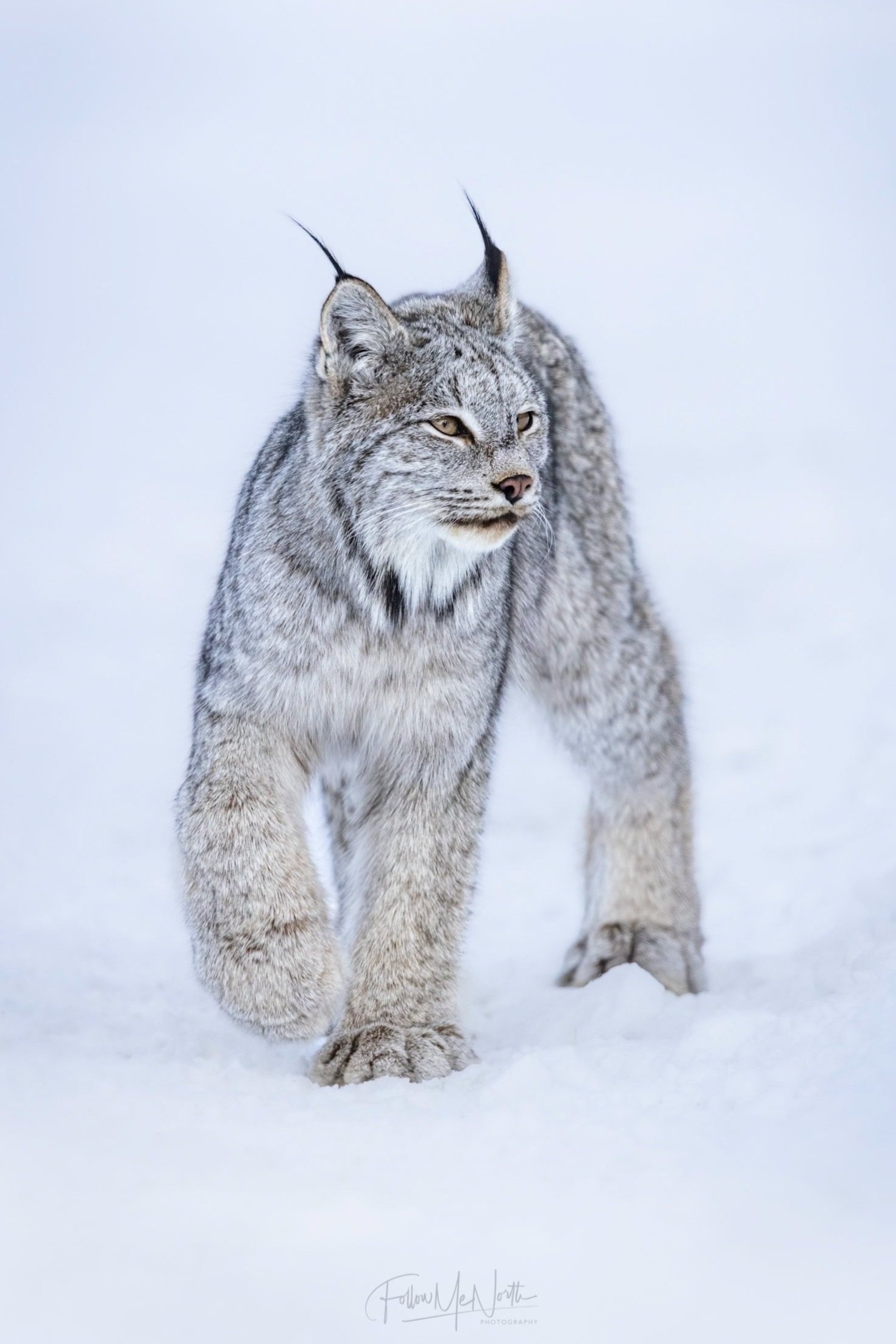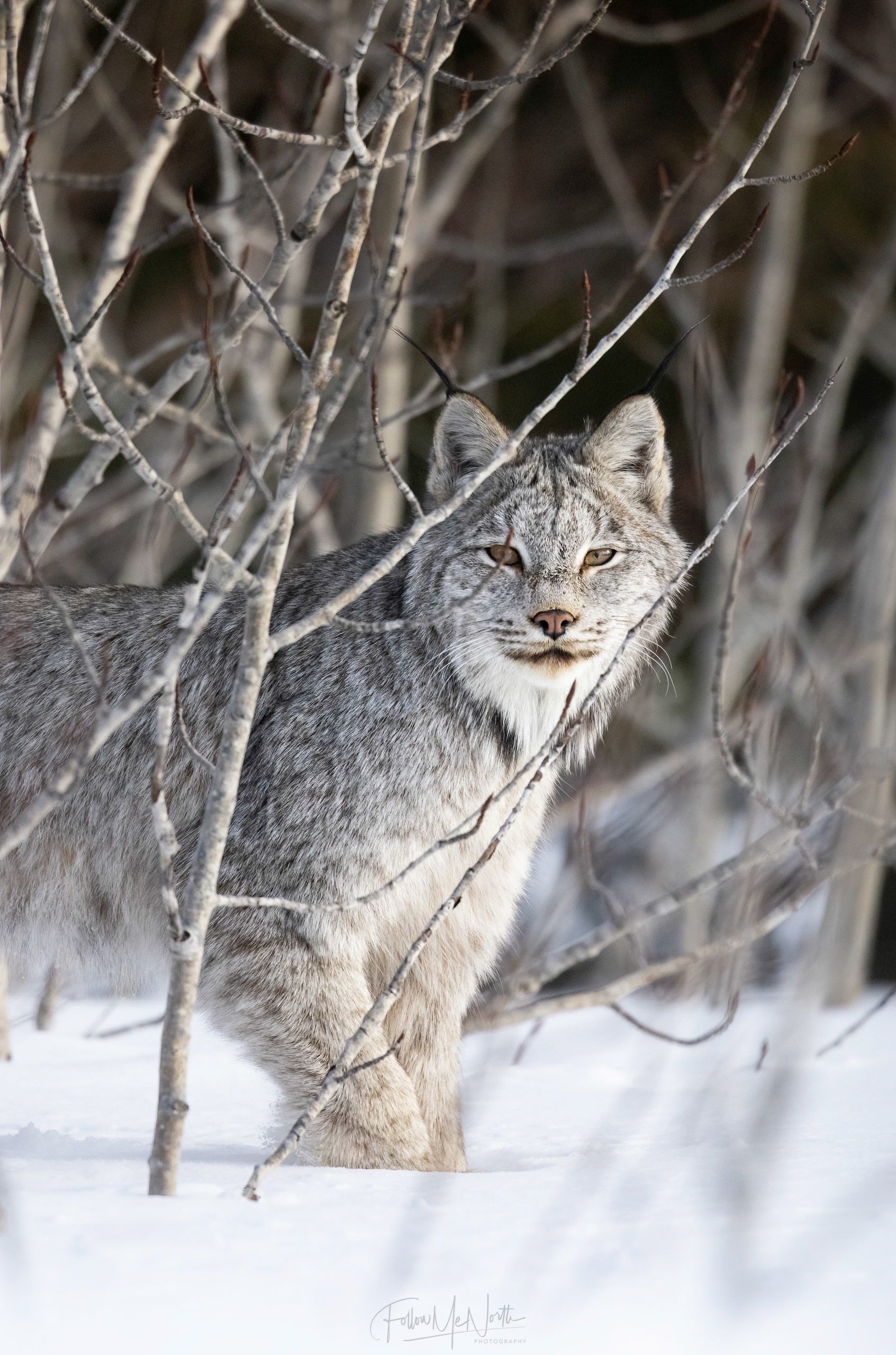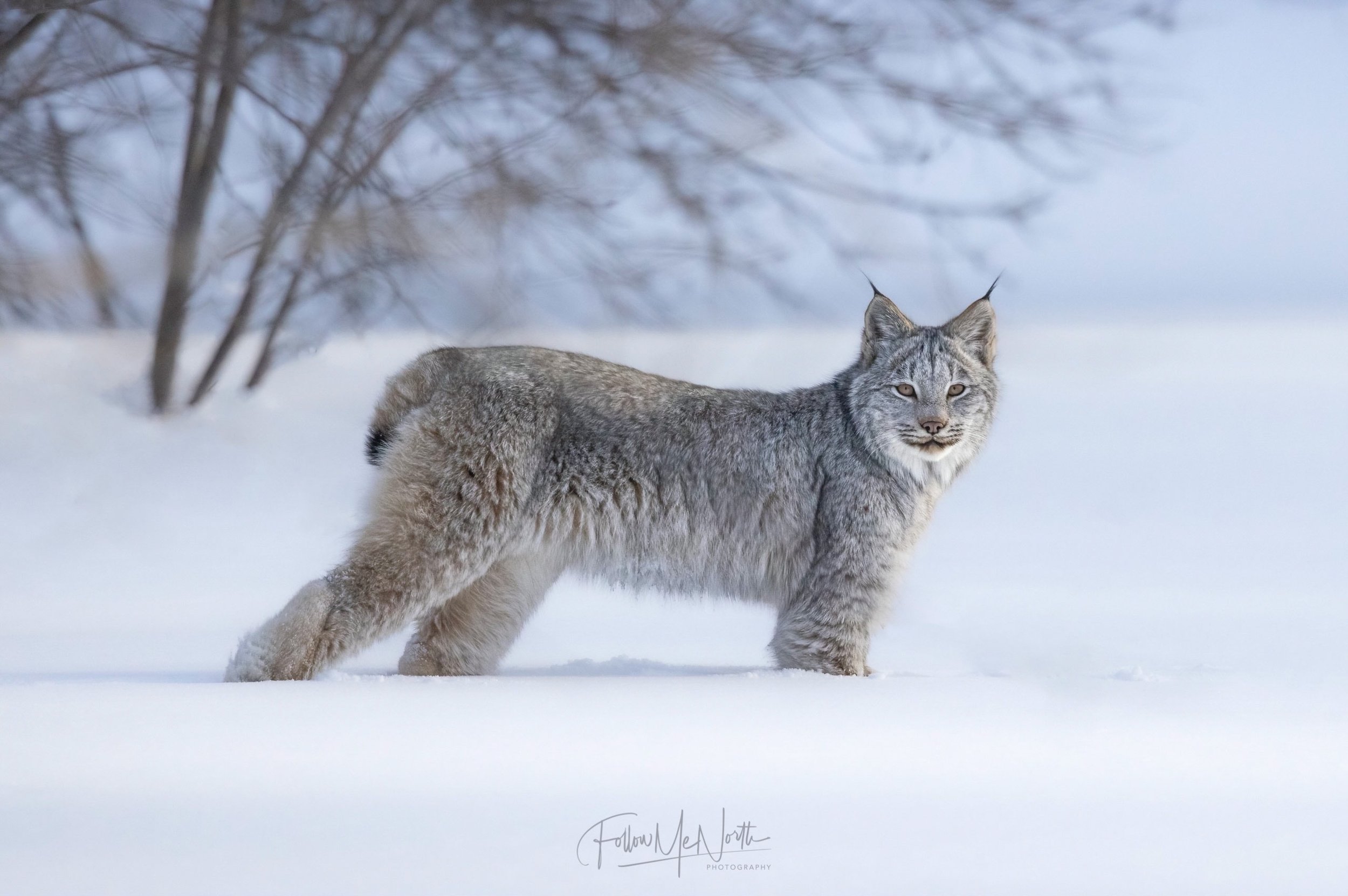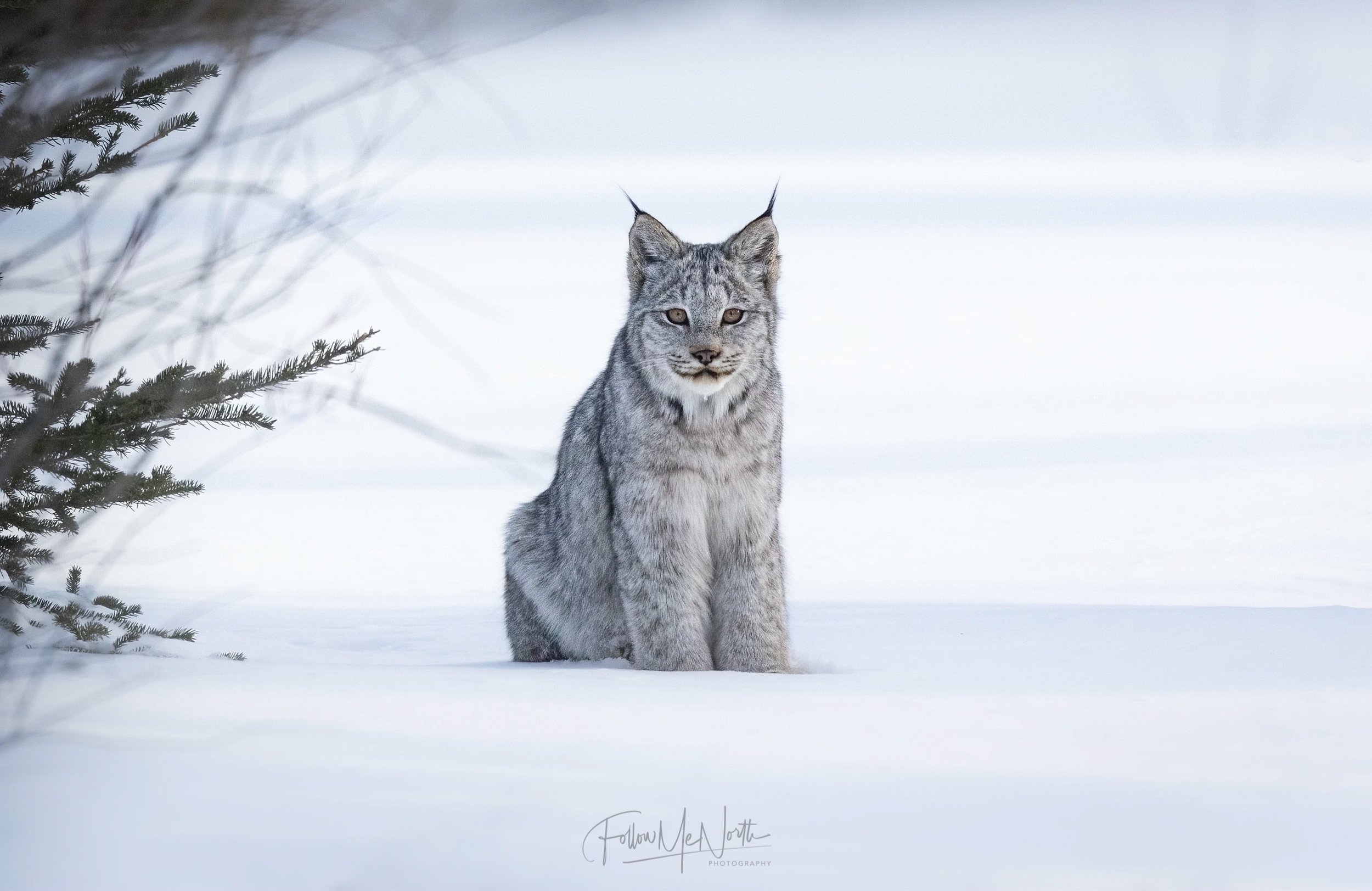Part 2: Canada Lynx Quest Continued
We’ve been running on adrenaline since encountering a proud female lynx and her four, healthy kits last week. After witnessing the lynxes rambunctious energy as they zipped through a sea of manicured trees in pursuit of a panicked snowshoe hare, we were determined to have more time with these ghostly, fuzzy-faced creatures.
Our previous adventure found us driving 1600 km in 36 hours to track these feisty feline’s in Northern, Ontario. At the time, we didn’t have pinpointed locations and were relying on fresh lynx and hare prints to reveal destinations worth investigating.
On this week’s trip, we wanted to give ourselves a larger grace period to find lynx and decided to create a fifteen-hour roundtrip and spend three nights in Canada’s true, rugged north - the land where people are properly snowed in until Spring. Our route was roughed in during the Winter of 2020, but we abandoned our plans to travel due to Covid-19. With more research behind us now, we refined our itinerary and began our 2330 km trek.
Sunday was beautiful, the perfect driving conditions and our circuit presented countless fresh hare prints along the roadways. Unfortunately, it wasn’t until we were 25 minutes from our hotel at sunset that we encountered a male lynx, too far from reach and moving with purpose. With no safe place to pull over on the highway, we missed him! It was the image that got away - dusk’s golden light dabbling over his whiskers as he danced across an untouched field of snow with muted, burnt orange browse. One for the memory bank! With heavy hearts, we grabbed a bite to eat and planned our morning roadmap and playlist.
Our first full day had a frosty start, with -39 temperatures we crossed our fingers that our vehicle would start. Thankfully, it did! Caffeinated and freshly fuelled, we found ourselves driving 310 km on lesser-known backroads.
When planning our expeditions we always factor in the species feeding schedule to maximize our chances. Knowing that lynx are most active at dawn and dusk as they’re nocturnal and evening hunters - we planned to be on the road in the morning between 7 a.m. to 10 a.m. and again in late afternoon, between 4 p.m. to 6 p.m. We enjoyed a few centimetres of fresh snow in the morning, which made tracking a great deal easier. We logged where we uncovered fresh hare and lynx prints, revisiting the same areas of activity multiple times throughout our outing. After several hours of anticlimactic searching, we retired for a Monday siesta.
We awoke newly recharged and to vibrantly dusted skies. With sleepy eyes, we hopped in the car and began scanning the roadways for tawny-coloured lynx butts. After hours of trying to see through layers of branches, we did a double take when we turned our second corner and discovered a yearling lynx walking towards us.
We were able to sit in the snow as the lynx observed us before disappearing into the adjacent forest - not 20 feet away. As we stood up, four more lynx kits appeared - all moving towards an open field in pursuit of their next meal.
We snapped images as they dispersed in different directions, glaring at the trunks of trees in search of lonely snowshoe hares to call their own. We were surprised to see they were undisturbed by our presence. One kit even laid down several feet away with its back turned to us, waiting for the cue from its siblings that dinner was served. This allowed us time to wade into the nipple-deep snow drifts to experiment with different compositions and angles.
After a generous 15 minute encounter, the lynx continued to move - pushing past three farm lengths of land. We followed at a respectful distance as they seamlessly weaved through branches and thick bush.
Then, seemingly out of nowhere, all four kits ran full tilt into a cluster of trees. A solo lynx appeared out of the shadows with a full grown hare dangling in its mouth before claiming its place on the forest floor to enjoy its prix fixe feast. The other kits sat, eyes fixated on their siblings ill-gotten gains. We looked on, in disbelief that we witnessed our second lynx hunt in a week. With the sun dipping now below the horizon line, we left the scene satisfied and ready to devour a feast of our own.
On our original schedule, we had ourselves leaving the following morning. However, we decided to gamble and signed up for another full day of exploration on Tuesday given our good fortune. Turns out, we should have cashed in our chips early, because our next full day proved to be uneventful - despite knowing their location the night before and seeing fresh tracks in the morning we ventured 450 km on the backroads to prove the scarcity of the elusive lynx once again. We were officially skunked.
Despite having less than an hours worth of lynx playtime in total between our two trips this week, we wouldn’t change our odds! We’re so grateful this lynx family revealed themselves to us. We hope our images create awareness and compassion for the well-being of these beautiful creatures, surviving in our fragile ecosystem. We believe nature heals. We hope this inspires you to venture outdoors, learn about your surroundings and enjoy the natural beauty that Mother Nature provides.
At the time of writing this blog, we are currently drawing up our next lynx route and we hope to share more magical winter images with you in the coming weeks!
Fun Facts About The Lynx-Snowshoe Hare Cycle
Lynx and Snowshoe Hares exist in a complex “boom-bust” cycle, with the success of lynx populations dependent on the availability of hare, says Yukon Department of Environment biologist, Tom Jung. Every nine to 11 years, the number of hare crashes, leaving the peaked lynx population with little to survive on.
For decades, scientists have been studying the predator-prey dynamic of lynx and hares in the Kluane region of the southwest Yukon and how climate change may affect their feeding patterns. What exactly a warming climate will mean for lynx depends in large part on how its primary prey, the snowshoe hare, is affected. In the forest, lynx have a clear hunting advantage in deep snow that can bog down coyotes. But in shallower snow lynx lose their edge, according to a Nature Climate Change study published in September 2020. Lead author, Michael Peers, tracked the fate of 321 snowshoe hares over four winters in the Kluane region as part of his PhD research at the University of Alberta. He found that hares face a significantly higher risk from predators, particularly coyotes, in shallower snow. Over the last two decades, maximum snow depth in the Kluane study region has fallen by 33 per cent. If climate change means a future with longer periods of shallower snow, Peers says, coyotes may kill more hares, adding hunting pressure that may depress the hare population, ultimately dragging down lynx numbers, as well.
When hares are plentiful, lynx eat little else and take about two hares every three days. Lynx prey upon mice, voles, squirrels, grouse, ptarmigan and carrion when hares are scarce. These food sources often don’t meet the lynx's nutritional needs. Some lynx cannot maintain their body fat reserves on this alternative diet and become vulnerable to starvation. When snowshoe hares are scarce, many lynx leave their home range in search of food. A recent study of 150 collared lynx headed by Knut Kielland, a professor of ecology with the University of Alaska, found the animals travelled great distances in search of food, with some collared lynx moving as far south as British Columbia and Alberta from their Alaskan roots. One specimen was tracked east of Great Bear Lake in the North West Territories all the way to Fairbanks in Alaska — an absolutely tremendous distance for an animal whose home range is typically 50 square kilometres.
At the peak of the “boom-bust” cycle, snowshoe hares can reach a density of up to 1500 hares per square km.
Malnourishment has the most significant effect upon lynx reproduction and population levels. When females are in poor condition, fewer breed and not all of those bred produce litters. Litters are smaller, and most, if not all, of the few kittens born die soon after birth. This means that for a period of three to five years, few or no kittens survive to adulthood. Studies have shown the level of kittens in a lynx population may be zero at the population low and as high as 60 percent when their numbers increase. Low lynx population levels last for three or four years. When hares become plentiful again, the lynx population begins to increase as well.
Location: PO Box 45 Baysville PO Baysville, Ontario Canada P0B 1A0
Phone: (705)-242-6621
Instagram: https://www.instagram.com/followmenorth/
Website: https://www.followmenorth.com/
















